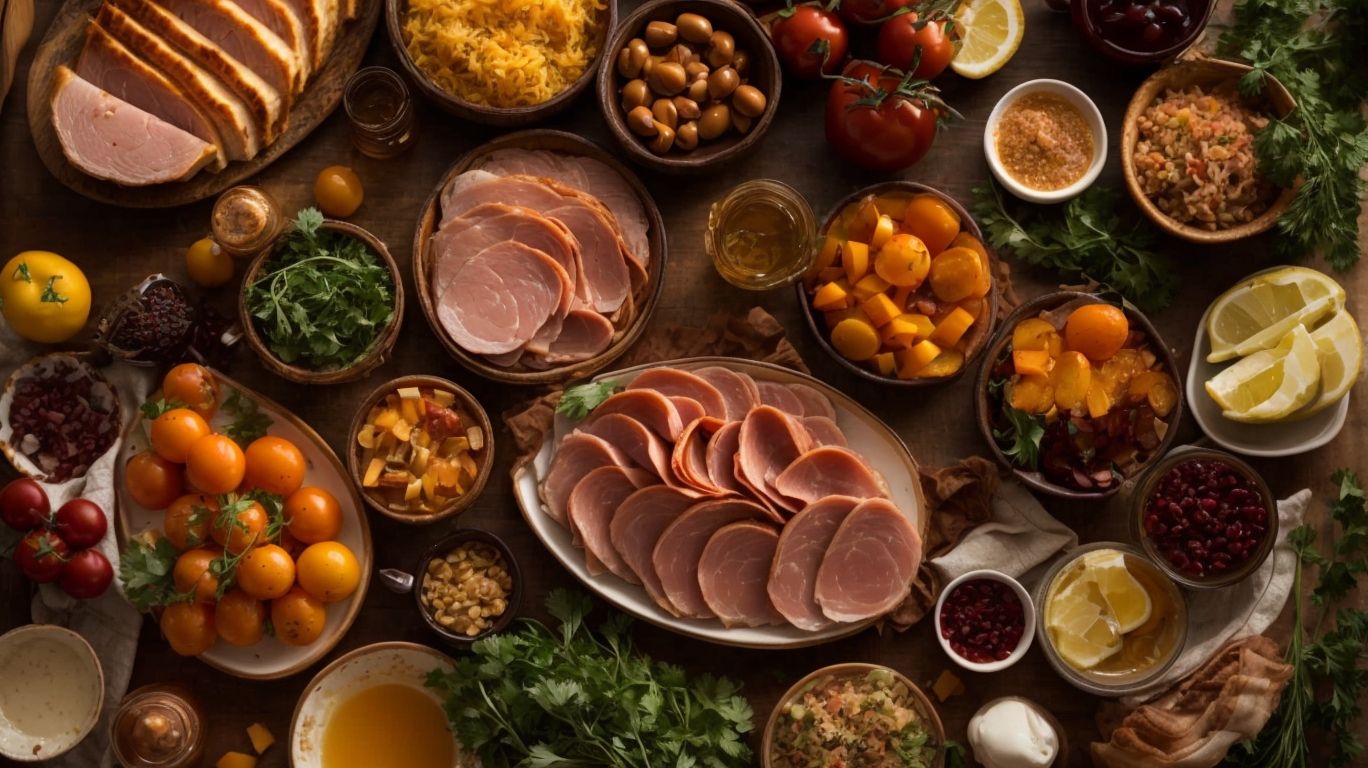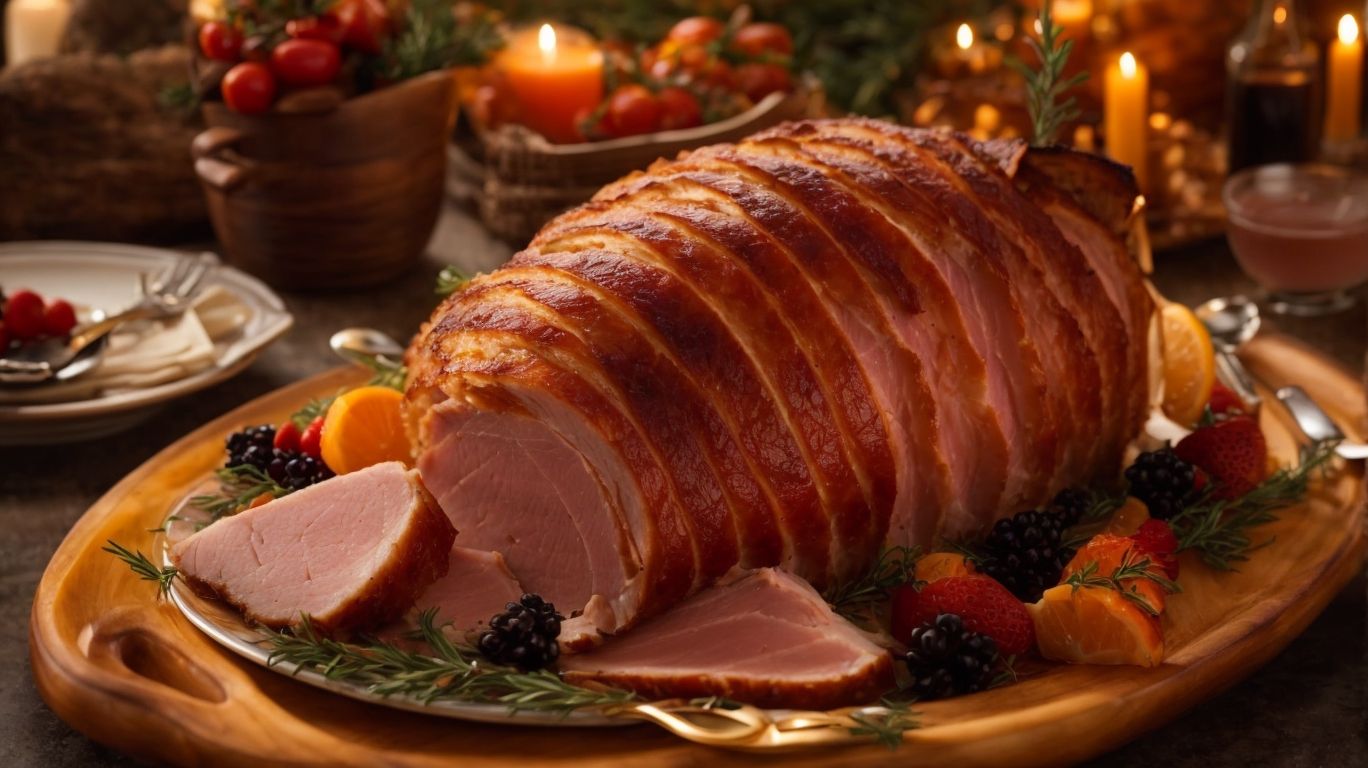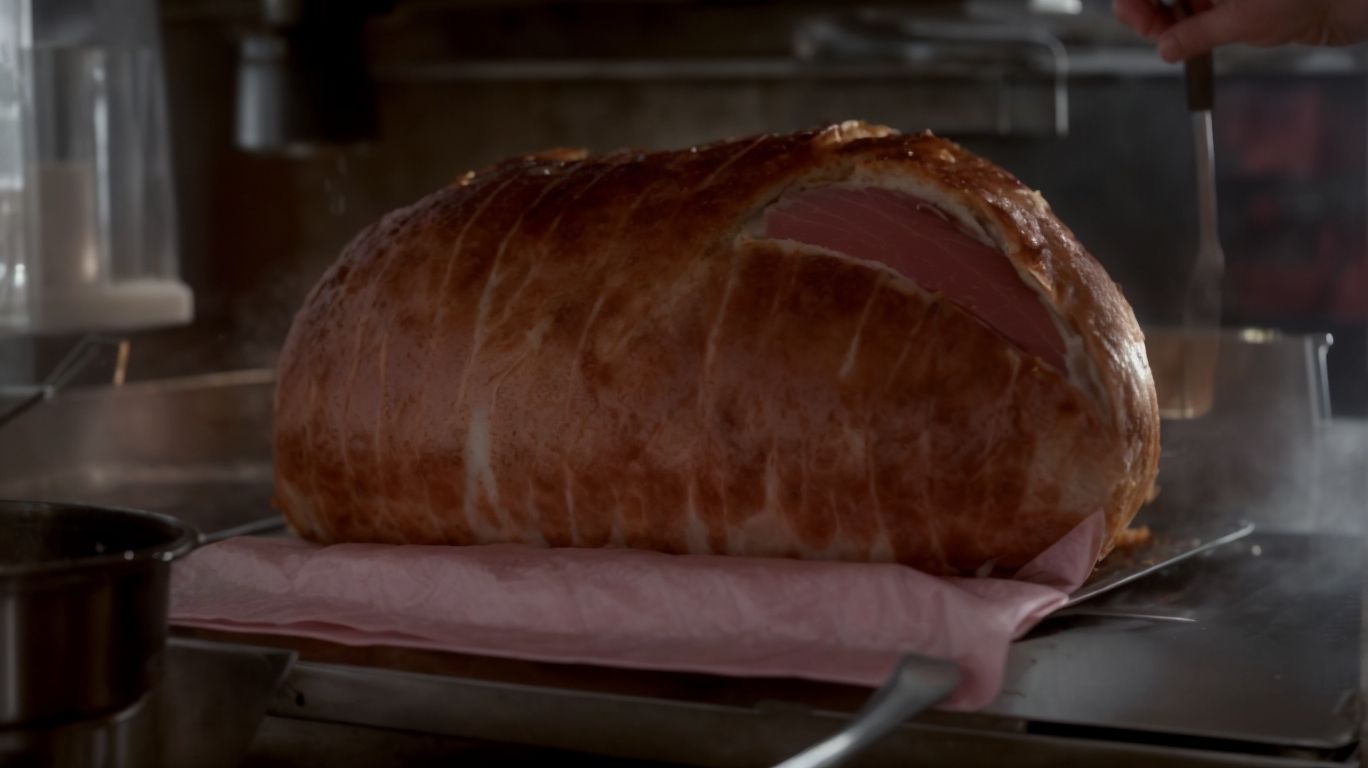How to Bake Ham After Boiling?
Welcome to Poormet.com, where we explore the art of cooking and baking delicious dishes. Today, we will be diving into the world of ham – from understanding the difference between fresh and cured ham to the benefits of boiling it before baking. We will also discuss the various ways to serve baked ham and the perfect side dishes to complement this savory main course. So, grab a seat and get ready to learn how to bake ham after boiling like a culinary pro!
Key Takeaways:
What is Ham?
Ham is a classic meat dish that is typically cured or smoked and often prepared by soaking in water. It can be cooked using various methods and requires a specific combination of ingredients.
Regarding preparing ham, the first step often involves either curing the meat with a mixture of salt, sugar, and other seasonings or smoking it to enhance the flavor profile.
The soaking process, known as brining, helps to tenderize the meat and infuse it with additional flavors. The ingredients used in the curing or brining process, such as herbs, spices, and liquids like apple cider or beer, play a crucial role in creating the distinct taste and aroma associated with this delectable meat.
What is the Difference between Fresh and Cured Ham?
The key difference between fresh and cured ham lies in the preservation process. While fresh ham is untreated and has a shorter shelf life, cured ham undergoes a method where it is salted and preserved for longer periods.
During the curing process, salt plays a crucial role. It not only acts as a preservative but also enhances the flavor and texture of the meat. The salt draws out moisture from the ham, which helps in inhibiting bacterial growth, thus extending its shelf life. The salt penetrates the meat, infusing it with a savory taste and creating a firmer texture compared to fresh ham. This process of curing transforms the ham into a delicacy sought after for its rich, complex flavors and distinctive aroma.
Why Boil Ham before Baking?
Boiling ham before baking serves as a crucial technique that helps to enhance the tenderness and juiciness of the meat, ensuring a flavorful outcome when it is baked.
By boiling the ham, the meat undergoes a process that not only helps to retain its moisture but also allows the flavors to infuse deeply into the fibers. This preparatory step softens the ham, making it more succulent and easy to slice, resulting in a delightful texture when consumed. Boiling the ham can also help in reducing the overall cooking time when it comes to baking, as the initial boiling renders the meat partially cooked, expediting the final baking process.
What are the Benefits of Boiling Ham?
Boiling ham offers several benefits, including making the meat more tender, juicy, and flavorful due to the cooking process that allows the flavors to infuse thoroughly.
When ham is boiled, the gentle, moist heat works wonders on tougher cuts of meat, breaking down the connective tissues and collagen to create a melt-in-your-mouth texture. This slow cooking method ensures that the ham remains succulent and doesn’t dry out, unlike other cooking techniques.
Boiling ham helps retain its natural juices, preserving its inherent flavors and enhancing them with the addition of aromatic herbs, spices, and vegetables. As a result, you end up with a dish that is not only delicious but also versatile for various meals and recipes.
What are the Different Ways to Boil Ham?
There are various methods to boil ham, ranging from simmering it in water with aromatic ingredients like cloves and bay leaf to using different cooking techniques that suit specific flavor profiles.
Some home chefs opt for slow cooking methods, like braising the ham in a flavorful liquid like apple cider or broth, which helps in keeping the meat moist and tender. On the other hand, others prefer the simplicity of boiling the ham in plain water, allowing the natural flavor of the meat to shine through.
Cloves and bay leaf are commonly used to add depth and warmth to the overall taste profile, but some may also experiment with spices like cinnamon or allspice for a unique twist.
How to Bake Ham after Boiling?
After boiling the ham, baking it ensures a crispy exterior and succulent interior. The process involves using specific ingredients to create a delicious and visually appealing dish.
Once the ham has been boiled to tender perfection, the baking stage adds a whole new dimension of flavor and texture. As the ham roasts in the oven, the exterior caramelizes, forming a mouthwatering crispy crust that contrasts beautifully with the moist, juicy meat inside.
- To achieve this delectable outcome, you’ll need ingredients like brown sugar, pineapple slices, cloves, and a glaze made from mustard and honey.
- Preheat the oven to 350°F, place the ham in a roasting pan, score the surface in a diamond pattern, and stud it with cloves.
- Spread the brown sugar over the ham, arrange the pineapple slices on top, and brush the mustard and honey glaze generously.
- Cover the ham with foil and bake for about an hour, basting periodically to lock in those flavors.
What are the Ingredients needed to Bake Ham after Boiling?
To bake ham after boiling, you will need ingredients like a flavorful glaze, sugar for caramelization, and other complementary elements that enhance the taste and appearance of the dish.
Alongside the essential glaze and sugar, incorporating aromatic spices such as cloves, cinnamon, or allspice can infuse the ham with added depth of flavor. Mustard and honey can create a tangy-sweet coating that balances the richness of the meat.
For a touch of acidity, don’t forget pineapple juice or apple cider vinegar, which can lend a bright contrast to the savory ham. A final flourish of molasses or maple syrup can bring a complex, caramelized note that elevates the overall presentation to decadent heights.
What are the Steps to Bake Ham after Boiling?
The process of baking ham after boiling involves specific steps such as glazing, roasting, resting, and carving, ensuring that the flavors are locked in and the meat is succulent.
After boiling the ham, the next crucial step is glazing the meat. This not only enhances the flavor but also gives the ham a beautiful, caramelized finish.
Once glazed, the ham is ready for roasting, a process that further tenderizes the meat and brings out its rich taste. After roasting, it is essential to let the ham rest before carving. This allows the juices to redistribute, ensuring that each slice is moist and delicious.
The act of carving the ham requires precision to serve up perfectly sized portions for everyone to enjoy.
What are the Tips for Baking Ham after Boiling?
When baking ham after boiling, consider basting it periodically to retain moisture, creating a delicious caramelized exterior, and using the cooking juices to prepare a flavorful gravy for serving.
By basting the ham, you not only keep it juicy but also infuse it with extra flavor as the juices mingle and caramelize during the baking process. Remember to use a brush or spoon to coat the ham evenly with the drippings. Don’t let the cooking juices go to waste!
- Simmer them on the stovetop with some herbs and spices to create a rich, savory gravy that will elevate your dish to the next level.
The combination of basting and utilizing the cooking juices ensures that every bite of your ham is bursting with succulent goodness. Enjoy the delicious results of your efforts!
What are the Different Ways to Serve Baked Ham?

Credits: Poormet.Com – Terry Perez
Baked ham can be served in various ways, such as glazed with honey for a sweet and savory flavor profile that appeals to different tastes and preferences.
For a more decadent twist, you can opt for a maple bourbon glaze, adding a rich and complex flavor that enhances the succulence of the ham. Creating an appealing presentation is key to tantalizing the senses before even taking the first bite. Consider garnishing the platter with fresh herbs like rosemary or thyme, or arranging the slices in an elegant spiral pattern on a festive serving dish. Such attention to detail not only elevates the visual appeal but also sets the stage for a memorable dining experience.
Glazed Baked Ham
A glazed baked ham is a culinary delight that features a caramelized sugar coating, enhancing the natural flavors of the meat and providing a perfect balance of sweetness and savory notes.
Preparation of a glazed baked ham starts with selecting a high-quality ham, preferably one that is not too lean to ensure succulence after baking. The ham is then scored and studded with cloves, imparting a hint of warm spice that complements the sweetness of the glaze. As the ham bakes, the caramelized sugar caramelizes, creating a shiny, flavorful crust that seals in the juiciness of the meat.
When it’s time to present the glazed ham, slicing it to reveal the glistening layers and aromatic steam is a moment of culinary satisfaction. The contrast between the rich, slightly sweet glaze and the savory, tender meat is what makes this dish a classic favorite for celebratory gatherings and festive occasions.
Honey Baked Ham
Honey baked ham offers a delectable combination of sweet and tangy flavors, with the honey glaze infusing the meat with a rich sweetness that complements its savory elements.
This beloved dish is a staple at festive gatherings, where its succulent moistness and caramelized exterior tantalize taste buds. The preparation process involves slow-roasting the ham to perfection, allowing the honey glaze to caramelize and form a delectable crust.
Pineapple Baked Ham
Pineapple baked ham combines the savory goodness of ham with the tropical sweetness of pineapple, creating a delightful contrast of flavors that is sure to please the palate.
This unique dish not only infuses a burst of tangy fruitiness into each bite but also offers a pleasant juxtaposition of textures—a tender, succulent ham paired with juicy, caramelized pineapple slices.
What makes this dish truly exceptional is how the pineapple imparts its natural sweetness, infusing the ham with a refreshing undertone that elevates the entire flavor profile.
What are the Side Dishes that go well with Baked Ham?

Credits: Poormet.Com – Benjamin Baker
Baked ham pairs beautifully with side dishes like creamy mashed potatoes and flavorful roasted vegetables, creating a well-rounded and satisfying meal for any occasion.
When serving baked ham, it’s essential to consider the balance of flavors and textures on the plate. Creamy mashed potatoes provide a delicious contrast to the savory ham, offering a smooth and comforting element to the meal. On the other hand, flavorful roasted vegetables add a pop of color and freshness, bringing a touch of brightness to the dish.
Combining these side dishes with the rich and salty ham creates a harmonious blend of tastes that complement each other perfectly. The creamy texture of the mashed potatoes, coupled with the crunch of the roasted vegetables, offers a delightful sensory experience that enhances the overall enjoyment of the meal.
Mashed Potatoes
Creamy mashed potatoes are a classic side dish that complements the savory richness of baked ham, with hints of garlic adding a flavorful touch to this comforting accompaniment.
When preparing these velvety mashed potatoes, start by choosing the right potatoes. Russet potatoes or Yukon Golds work well due to their high starch content, resulting in a creamier texture. After peeling and cutting the potatoes into uniform chunks, boil them until they are fork-tender. While mashing, add warm milk or cream gradually to achieve the desired creaminess. To enhance the garlic flavor, infuse minced garlic in butter and mix it into the mashed potatoes.
For variations, try incorporating grated Parmesan cheese or chives for added depth of flavor. You can also experiment with sour cream or cream cheese for a tangier twist. Season with salt and pepper to taste and garnish with fresh herbs like parsley or chives for a touch of freshness. These variations elevate the traditional mashed potatoes and make them a standout side dish for any meal.
Roasted Vegetables
Roasted vegetables such as Brussels sprouts and carrots offer a delightful contrast to the richness of baked ham, providing a colorful and nutritious addition to the meal.
When preparing roasted Brussels sprouts, it’s crucial to ensure they are trimmed and halved for even cooking, allowing their natural sweetness to caramelize and their outer leaves to become irresistibly crispy. The addition of carrots brings not just vibrant color but also a hint of natural sweetness that complements the savory notes of the ham perfectly.
Visually, the mix of green and orange hues on the plate creates a striking presentation that enhances the overall dining experience, appealing to both the eyes and the taste buds. Nutritionally, these vegetables are packed with vitamins, minerals, and fiber, adding a healthy component to the indulgent meal.
Scalloped Potatoes
Scalloped potatoes, with their creamy texture and cheesy goodness, offer a decadent side dish option that perfectly complements the savory flavors of baked ham.
Preparation of scalloped potatoes involves thinly sliced potatoes layered in a creamy mixture of milk, butter, and cheese, then baked to a golden perfection.
The key to achieving the ideal scalloped potato dish lies in selecting the right combination of cheeses, such as sharp cheddar for a bold flavor or gruyere for a more delicate touch.
For a gourmet twist, you can add ingredients like caramelized onions, crispy bacon crumbles, or a sprinkle of fresh herbs like thyme or rosemary to elevate the dish to a whole new level of sophistication.
Conclusion

Credits: Poormet.Com – Christopher King
In conclusion, ham is a versatile dish that can be prepared in various ways, from boiling to baking, offering a range of flavors and textures to suit different tastes and occasions.
Whether you prefer a savory and succulent roast ham with a crispy glaze or a tender and juicy boiled ham flavored with aromatic spices, there is a preparation method to satisfy every palate. Ham can also be smoked, grilled, or even fried to achieve different levels of smokiness and char that cater to diverse taste preferences. Its adaptability extends beyond traditional holiday dinners, as it can be incorporated into sandwiches, salads, pasta dishes, and more, adding a delicious, savory element to any meal.
Frequently Asked Questions
How to Bake Ham After Boiling?
Here are some frequently asked questions about baking ham after boiling:
1. What is the recommended cooking time for baking ham after boiling?
The recommended cooking time for baking ham after boiling is about 20 minutes per pound of ham at 325 degrees Fahrenheit.
2. Should I remove the ham from the boiling water before baking?
Yes, it is important to remove the ham from the boiling water before baking. This will prevent the ham from becoming overcooked and dry.
3. What temperature should I set my oven to for baking ham after boiling?
The oven should be preheated to 325 degrees Fahrenheit for baking ham after boiling.
4. Can I add any seasonings or glaze to the ham before baking?
Yes, you can add your preferred seasonings or glaze to the ham before baking. This will enhance the flavor and add a nice crust to the ham.
5. How do I know when the ham is fully cooked?
The ham is fully cooked when the internal temperature reaches 145 degrees Fahrenheit. Use a meat thermometer to check the temperature in the thickest part of the ham.
6. Can I bake the ham in advance and reheat it later?
Yes, you can bake the ham in advance and reheat it later. Just make sure to cover it with foil and reheat in the oven at 325 degrees Fahrenheit for about 10-15 minutes per pound.

